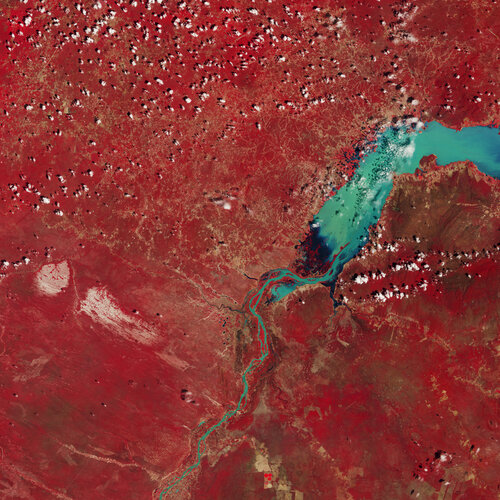This Copernicus Sentinel-2 image highlights part of the São Francisco River in eastern Brazil.
With a course of 2914 km, the São Francisco is the fourth largest river system in South America and the largest river located wholly in Brazil. It is also sometimes called the “river of national unity” because its basin extends across several Brazilian states.
Rising 730 m above sea level in the southwestern state of Minas Gerais, the river flows northerly to the state of Bahia. It then flows to the Atlantic Ocean, where it empties between the states of Alagoas and Sergipe. Several hydroelectric plants along the river’s course provide power throughout northeastern Brazil.
The image shows in light blue the course of the river in northern Bahia, where it forms the extensive Sobradinho Reservoir. A combination of sediment, decomposing plants and the presence of algae and microorganisms give the water its bright hue.
Covering an area of about 4200 sq km, Sobradinho is one of the largest artificial lakes in the world, and can hold more than 34 billion cubic metres of water, although its water level varies with seasonal changes.
This false-colour image has been processed using Sentinel-2’s near-infrared channel, which highlights vegetation in red and helps us better distinguish between areas with vegetation and areas without.
We can see where vegetation has been cleared away for logging, farming and land cultivation. Cities, roads and agricultural fields appear in different shades of brown.
A distinctive feature in this image is the area of circles at the bottom centre. These were created by a central-pivot irrigation system, where a long water pipe rotates around a well at the centre of each plot. The varying colours show different types of crop, or different stages of growth.
Copernicus Sentinel-2 is designed to monitor changing lands, including crop type and health. The mission’s frequent revisits over the same area and high spatial resolution also enable close monitoring of changes in inland water bodies.



 Image:
This Copernicus Sentinel-2 image highlights part of the São Francisco River in eastern Brazil.
Image:
This Copernicus Sentinel-2 image highlights part of the São Francisco River in eastern Brazil.